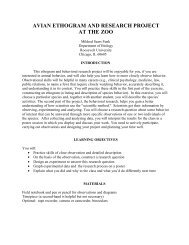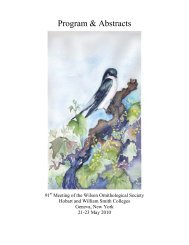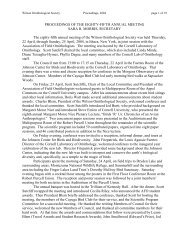OPTIMAL FORAGING BEHAVIOR: GROUP VS. SOLITARY ...
OPTIMAL FORAGING BEHAVIOR: GROUP VS. SOLITARY ...
OPTIMAL FORAGING BEHAVIOR: GROUP VS. SOLITARY ...
Create successful ePaper yourself
Turn your PDF publications into a flip-book with our unique Google optimized e-Paper software.
PROCEDURE<br />
Previous studies suggest that when food is approximately evenly dispersed in an<br />
environment, solitary foraging yields a higher energy return per unit time (or less time to<br />
acquire a set amount of energy) (Verbeek 1973). Alternatively, when food is clumped,<br />
flock foraging is more efficient (Zahavi 1971, Krebs et al. 1972). To let students<br />
experience these non-intuitive concepts, this exercise lets students be “foragers”<br />
searching for “prey.” The foraging environment is the classroom, prey are colored note<br />
papers attached to the underside of desks or chairs, and the birds are students. Four basic<br />
trials are conducted in this exercise to test the following hypotheses.<br />
Hypothesis 1. There is no difference in time required to locate and capture<br />
prey necessary to meet energy requirements between solitary and flock<br />
foragers when food is evenly (approximately) distributed in space.<br />
Alternative Hypothesis 1a. Solitary foragers require less time to locate and capture<br />
prey than flock foragers when food is evenly (approximately) distributed in<br />
space.<br />
Hypothesis 2. There is no difference in time to acquire prey needed to meet energy<br />
requirements between group and solitary foragers when food is patchily<br />
distributed (clumped) in space.<br />
Alternative Hypothesis 2a. Group foragers require less time than solitary foragers<br />
to acquire prey to meet needed energy demand when food is patchily<br />
distributed (clumped) in space.<br />
Classrooms of almost any size can be used for this exercise, but very small ones (ca. 20<br />
desks) introduce larger chance variation in the results. I have used the experiment<br />
successfully in banked or flat classrooms with from 60 to >100 desks (or chairs).<br />
Separate trials (with replicates if desired) with solitary and with flock foragers are<br />
conducted to test each hypothesis resulting in 4 different trials.<br />
For Trial 1 (solitary foragers; food evenly dispersed), 12 sticky notes (all of a single<br />
color, e.g., blue) are placed in a widely dispersed (pseudo-uniform) pattern on the<br />
underside of desktops or chairs. Nine student volunteers are gathered outside the<br />
foraging patch (e.g., at the front of the class). Other students act as timekeepers. On a set<br />
signal the student foragers begin searching for food (sticky notes) in the foraging patch<br />
(set of desks). Students are told that once they find and “capture” a food item (i.e., met<br />
their daily energy need) they should leave the foraging patch. Total elapsed time from<br />
beginning of search until a prey item is captured is recorded for each student forager<br />
(alternatively total time elapsed until the last of the 9 foragers captures a food item can be<br />
recorded).<br />
For Trial 2 (group foraging, food evenly dispersed), 12 sticky notes (of a different color,<br />
e.g., yellow) are again distributed in a widely dispersed pattern in the classroom. Again 9





